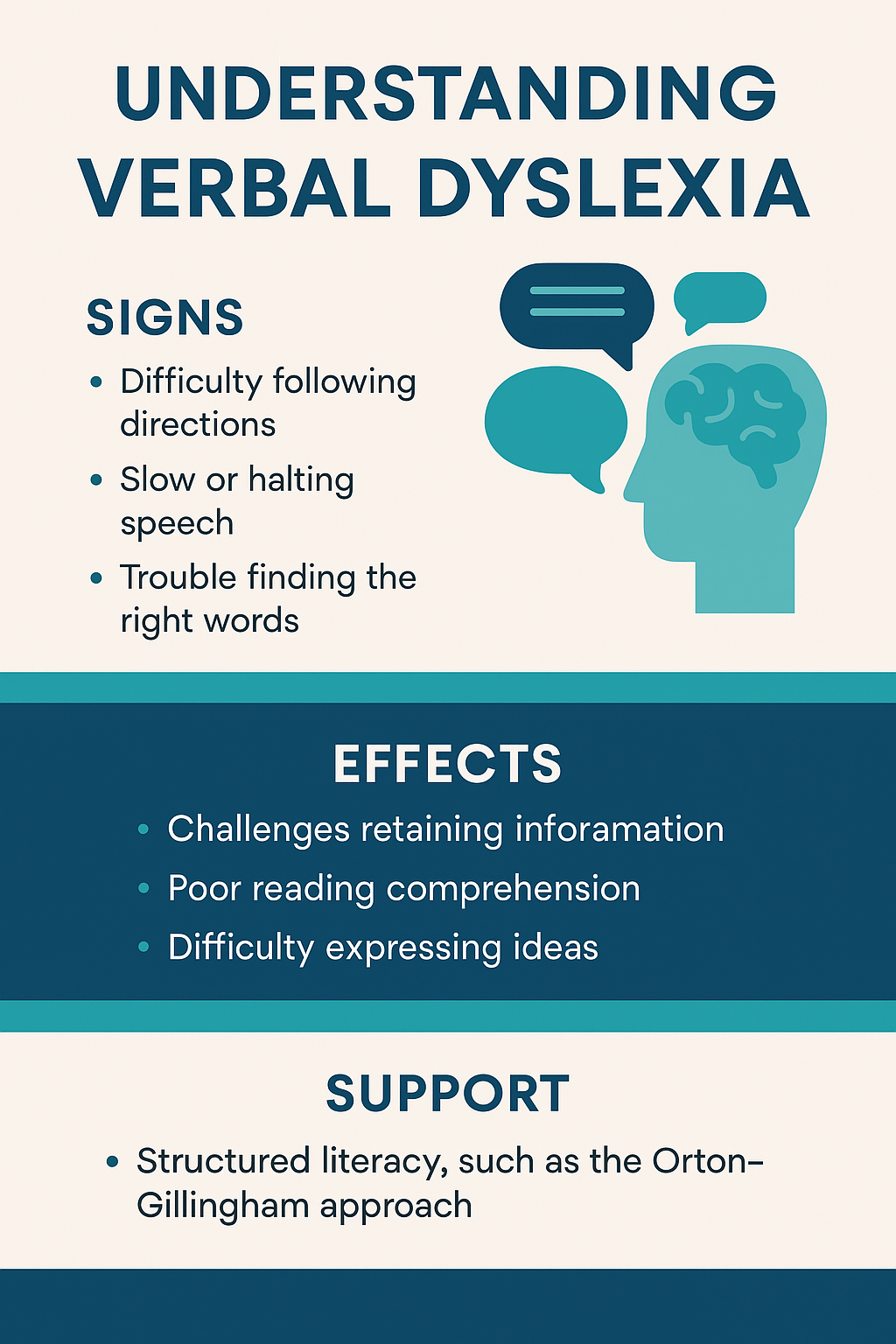
If you’ve never heard of verbal dyslexia, you’re not alone. This lesser-known type of dyslexia doesn’t show up in reading alone. Instead, it affects how a child hears, processes, recalls, and expresses language verbally. While traditional dyslexia typically impacts reading and spelling, verbal dyslexia interferes with oral language and working memory. And unless it's properly addressed, it can make reading, writing, and even social interaction a daily battle.
As someone who’s worked with struggling readers for over a decade, I’ve seen how verbal dyslexia quietly derails student progress. Kids are labeled as inattentive, slow, or even defiant—not because they don’t understand, but because they can’t get the words out fast enough or hold onto spoken instructions long enough to follow them.
So what exactly is verbal dyslexia, how do you identify it, and most importantly—how do you support kids who have it? This post breaks it down.
What Is Verbal Dyslexia? A Closer Look at This Hidden Learning Difficulty
Verbal dyslexia is a form of dyslexia that affects language processing—particularly listening comprehension, verbal recall, word retrieval, and oral expression.
Unlike visual dyslexia, which impacts the decoding and reading of print, verbal dyslexia affects the brain’s ability to hear, store, and reproduce language sounds in real time. Kids with verbal dyslexia may:
-
Struggle to remember multi-step directions
-
Have trouble finding the right words during conversation
-
Mix up sounds or syllables when speaking
-
Struggle with verbal storytelling or retelling events
-
Get overwhelmed in fast-paced discussions or group work
This has huge consequences—not just academically, but socially. A child who can’t respond quickly in a conversation may withdraw or be labeled “shy,” when the truth is they’re overwhelmed by verbal demands.
It is important to stop the negative effects of dyslexia before they overtake a child's confidence and stop academic progress. Early intervention like Orton Gillingham is crucial.
Verbal Dyslexia vs. Traditional Dyslexia: What’s the Difference?
Both types of dyslexia are rooted in language processing challenges—but they show up in different ways.
Here’s a quick comparison:
| Feature | Traditional Dyslexia | Verbal Dyslexia |
|---|---|---|
| Affects | Reading, spelling, decoding | Listening, speaking, verbal memory |
| Signs | Word reversals, slow reading | Forgetting words, verbal confusion |
| Testing | Phonological and decoding tests | Language processing assessments |
| Misunderstood as | Poor reader | Inattentive or slow thinker |
The scary part? Verbal dyslexia often goes unnoticed because these kids may read okay on paper—but still struggle deeply with comprehension and communication.
Verbal Dyslexia and the Brain: What the Science Says
Research shows that children with verbal dyslexia have underactivation in the areas of the brain responsible for processing spoken language. This includes parts of the left temporal lobe, which is key for speech sound analysis and memory.
This affects:
-
Auditory working memory: holding onto sounds or verbal directions
-
Phonological retrieval: finding and producing words quickly
-
Processing speed: the ability to respond to verbal input in real-time
This means kids with verbal dyslexia might understand what you’re saying but still have trouble responding, especially under time pressure. And that can make school brutal.
How Verbal Dyslexia Shows Up in the Classroom
As a teacher or parent, you may have seen signs of verbal dyslexia without realizing it. Here’s what it often looks like:
-
A student who freezes when called on
-
A child who forgets simple directions unless they’re written down
-
A kid who can read aloud fluently but struggles to explain what they read
-
A student who talks around words, saying “that thing” or “you know” often
-
A child who can’t follow multi-step directions
These behaviors are often mistaken for attention issues or lack of effort. But in reality, the student’s brain is just overwhelmed with verbal load.
How to Support a Child with Verbal Dyslexia
Here’s the good news: students with verbal dyslexia can absolutely thrive when given the right support.
The key is to reduce verbal overload and build structured language pathways. That’s where a systematic, multisensory program like our Orton-Gillingham Curriculum comes in.
Here’s what works:
-
Use visual supports – Pair spoken instructions with visuals, written words, or icons.
-
Slow down – Give students processing time before asking for a response.
-
Teach phonological awareness – Even older students benefit from sound awareness work.
-
Practice verbal rehearsal – Give kids a chance to repeat and “rehearse” before sharing aloud.
-
Use decodable books and structured language practice – Our Teach Me to Read Workbook is great for this.
-
Break tasks into chunks – Multi-step directions should be one step at a time.
-
Model word retrieval strategies – “Tell me what it looks like,” or “what does it start with?”
Why Structured Literacy Helps Students with Verbal Dyslexia
The Science of Reading tells us that all students benefit from explicit, systematic, cumulative instruction—but for students with verbal dyslexia, it’s essential.
Why? Because OG-based approaches:
-
Reinforce phonological awareness
-
Build oral and written language side-by-side
-
Reduce memory load by using predictable routines
-
Provide repeated exposure to sound-symbol correspondences
-
Use multisensory techniques that anchor language in more than just sound
Our Structured Literacy Curriculum for grades 3-5 was built with these needs in mind. Whether your child struggles with decoding or language expression, this curriculum meets them where they are.
Final Thoughts: Don’t Let Verbal Dyslexia Stay Hidden
Verbal dyslexia is often missed—not because it’s rare, but because we haven’t been trained to see it. These students may be articulate one moment and tongue-tied the next. They may ace a written worksheet but melt down during oral presentations.
When we recognize verbal dyslexia for what it is—a language-based processing issue—we can stop blaming students for what they can’t control and start giving them tools that work.
And if you’re looking for materials that support oral language, phonological awareness, and reading all in one place, I’d love for you to check out our Orton-Gillingham curriculum here.
Because when we give kids the right tools, we don’t just help them speak or read—we help them thrive.
